Key takeaways:
- World-building creates immersive experiences by intertwining lore, player choices, and dynamic environments.
- Effective worlds possess unique cultures, detailed histories, and meaningful interactivity that enhance player engagement.
- Incorporating environmental storytelling and player agency strengthens emotional connections to the game world.
- Practical tools like map-making software and collaborative platforms streamline the creative process for world-builders.

Understanding world-building in games
World-building in games is much more than just creating a backdrop; it’s about crafting a living, breathing universe that players can immerse themselves in. I remember my early days of game design, when I built a simple platformer. It was fascinating to see how the tiniest details, like a unique sky color or interesting NPC dialogues, could transform bland levels into a memorable experience.
Think about your favorite games—what makes their worlds so captivating? For me, it’s the sense of depth and history. When I play a game that seamlessly weaves lore into gameplay, I feel a connection to the characters and the setting. This cultural richness invites players to explore, to uncover secrets, and to engage with the narrative on a personal level.
Moreover, effective world-building balances consistency with creative freedom. I recall a project where I spent countless hours adjusting the ecosystem to ensure each creature had a role that impacted gameplay. It was a labor of love, but the rewards were clear when players commented on how alive the world felt. This engagement is crucial; it’s the heartbeat of the game and can transform a good game into an unforgettable one.
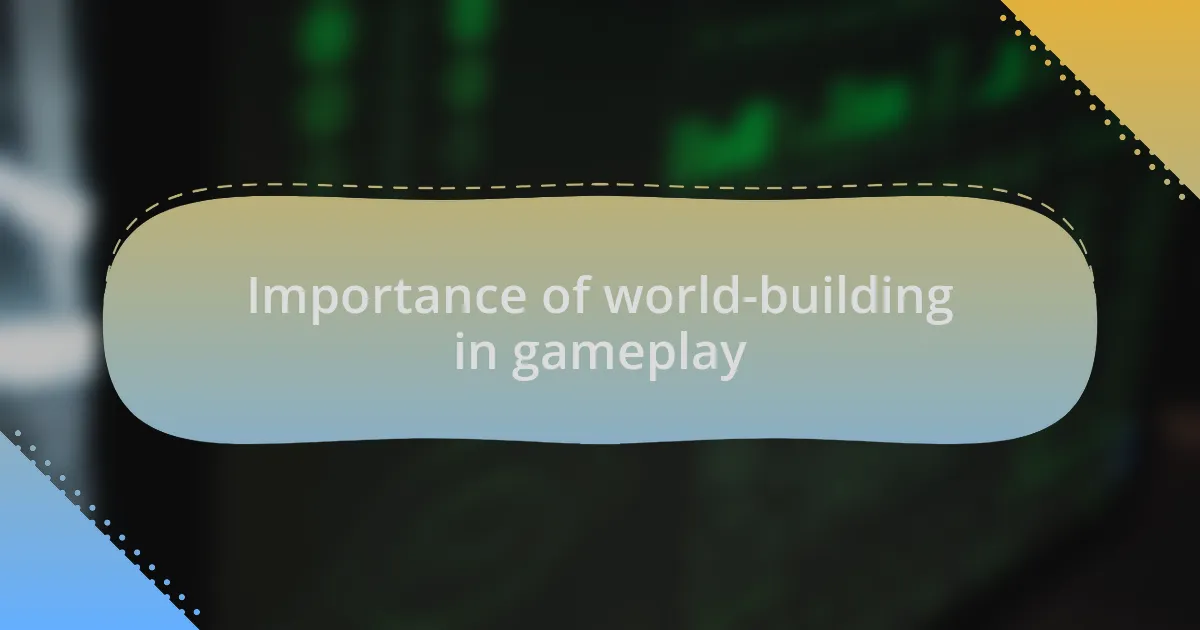
Importance of world-building in gameplay
World-building can dramatically enhance player engagement by establishing a sense of place that feels authentic. I often find myself captivated by the rich environments in games, where the stories whisper through the trees or echo in abandoned buildings. I remember one project in particular where I deliberately placed objects that hinted at the history of a once-thriving civilization. Players would stop to examine these details, sparking their imaginations and inviting them to create their own narratives around the world.
When a game world feels alive, players are more likely to invest their emotions into it. I once played a game where the changing seasons not only altered the visuals but also impacted gameplay and storylines. This dynamic approach made every playthrough feel fresh and urgent. What if players could influence the world around them? This question guides my design philosophy and fuels my desire to create experiences where players feel their choices matter.
Ultimately, well-crafted worlds invite exploration and discovery, aspects that keep the gameplay exciting. I recall hearing players excitedly share their favorite hidden locations and the lore behind them. Those moments of connection, both with the game and with other players, showcase the power of immersive world-building. It’s that shared joy of discovery that makes every pixel worth crafting.
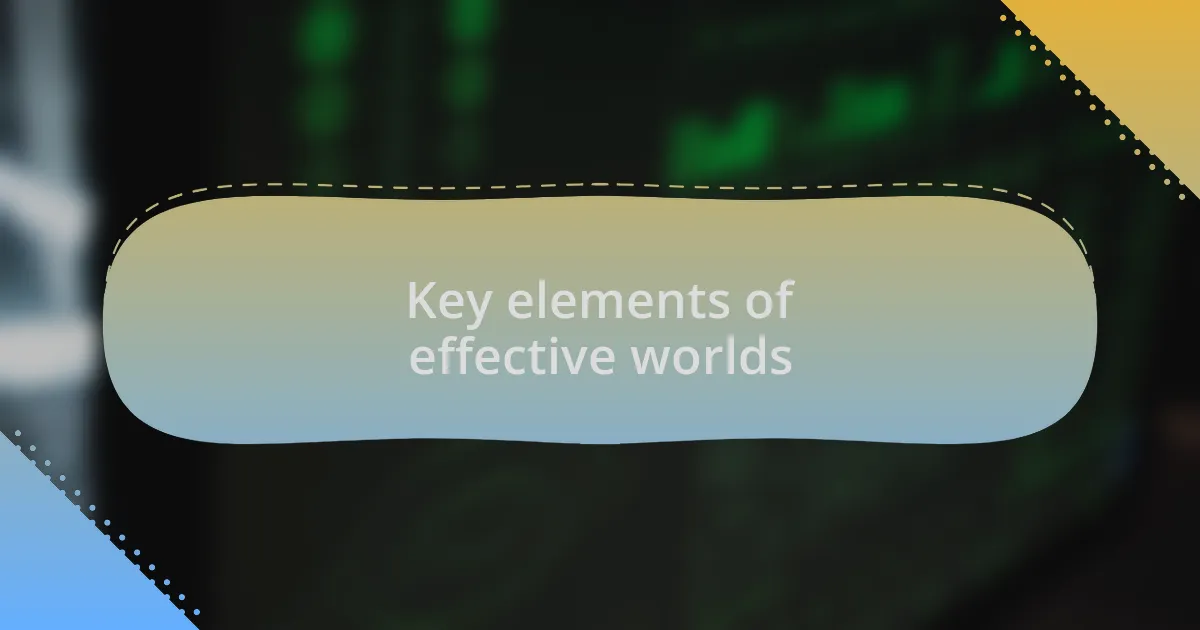
Key elements of effective worlds
To create an effective game world, layering depth is essential. I’ve found that including unique cultures, languages, and traditions can make a world feel truly vibrant. For example, in one game I worked on, I crafted a fictional language that players could discover through ancient texts. This added an intriguing puzzle for players while immersing them deeper into the lore.
Atmosphere is another key element that can’t be overlooked. I remember a project I led where the use of sound design – from distant thunder to the soft rustle of leaves – transformed an ordinary forest scene into something enchanting. How often do players remember the ambiance that pulled them into a world? By thoughtfully integrating audio and visual elements, I’ve seen players become emotionally invested in environments that once seemed mere backdrops.
Moreover, meaningful interactions with the environment amplify player engagement. I once implemented a weather system that influenced NPC behavior and quest availability. It was fascinating to see players adapt their strategies based on weather changes, sparking discussions about tactics and experiences. In my experience, when players realize their interactions have consequences, it creates a powerful connection to the game world.
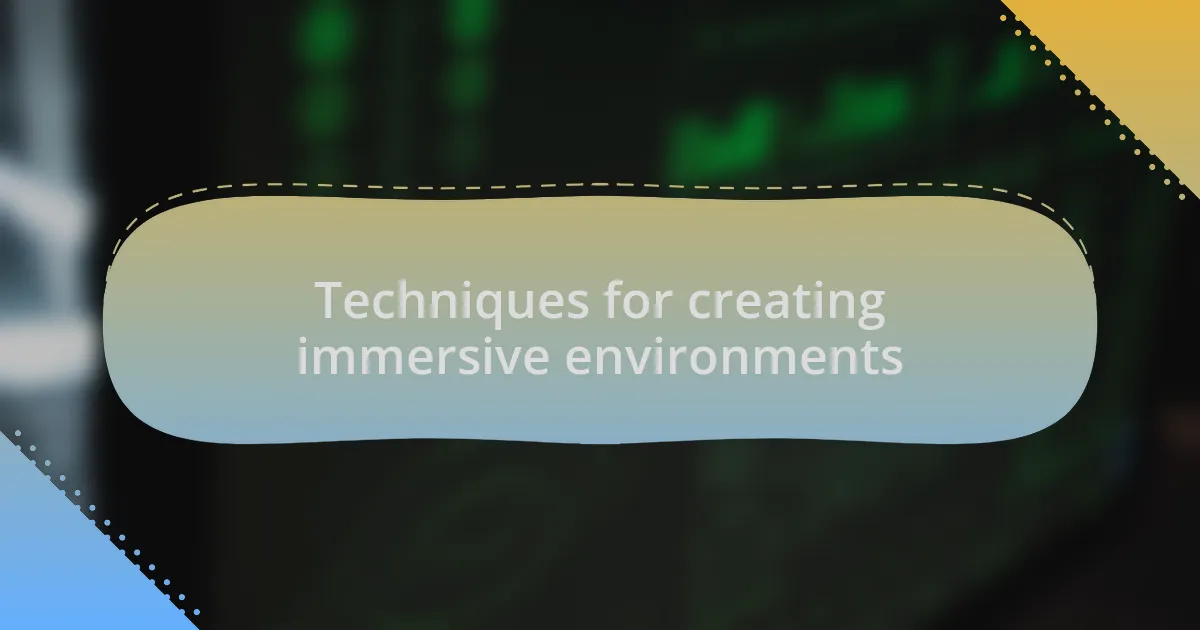
Techniques for creating immersive environments
One technique I find crucial for creating immersive environments is the incorporation of environmental storytelling. When I developed a post-apocalyptic city, I scattered remnants of the past—like crumbling photos and abandoned toys—across the landscape. Each item sparked curiosity, prompting players to piece together the history of the world. Don’t you think this kind of discovery can make players feel like detectives unraveling a compelling narrative?
Another approach I’ve used successfully is dynamic lighting. In one project, we designed a cave system where the flickering torches cast eerie shadows, creating an unsettling atmosphere. I noticed players would hesitate at corners, anticipating what dangers lurked just beyond the light. Have you ever felt that tension in a game? That’s the kind of emotional response I aim to evoke through thoughtful illumination.
Lastly, embracing player agency in the environment can enhance immersion exponentially. In my experience with an open-world game, we allowed players to change the landscape itself—like cutting down trees to create paths. Watching players make impactful decisions about their surroundings made me realize how invested they became in their unique journey. Isn’t it fascinating how giving players control can transform their relationship with the game world?
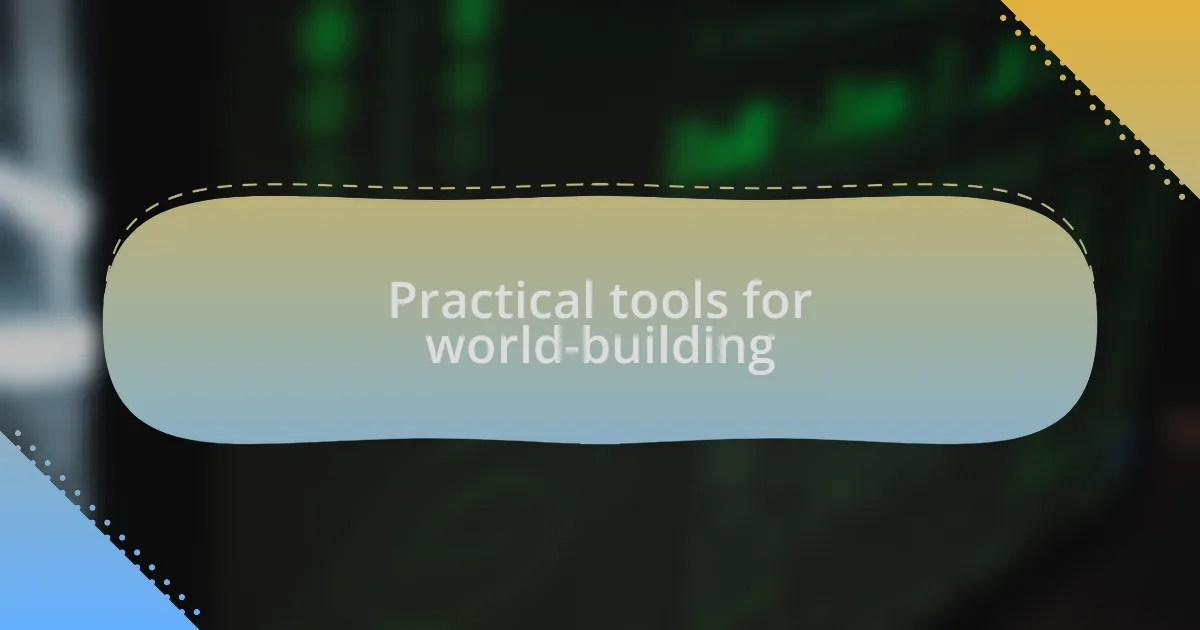
Practical tools for world-building
When it comes to practical tools for world-building, I find map-making software incredibly useful. Programs like Inkarnate and Wonderdraft allow me to visualize my game’s geographical layout in stunning detail. I remember the excitement I felt when I first crafted a sprawling fantasy world; drawing those mountains and rivers helped me understand my narrative’s scope. Have you ever experienced that surge of creativity just by mapping out your ideas?
Another essential tool in my arsenal is world-building templates. Using platforms like World Anvil or Scrivener provides structured prompts that guide me through the complexities of different cultures, economies, and histories. I once used World Anvil to flesh out a civilization with unique customs and beliefs, and it felt like diving into a rich tapestry of interconnected ideas. Isn’t it amazing how a simple template can unlock so many creative pathways?
Finally, I can’t underestimate the power of collaborative platforms. Tools like Google Docs or Trello not only help organize my thoughts but also allow for seamless feedback from my team. I remember working on a game where we brainstormed ideas in real time, and the energy was infectious. How have collaboration tools impacted your own creative processes? They can truly elevate the world-building experience!
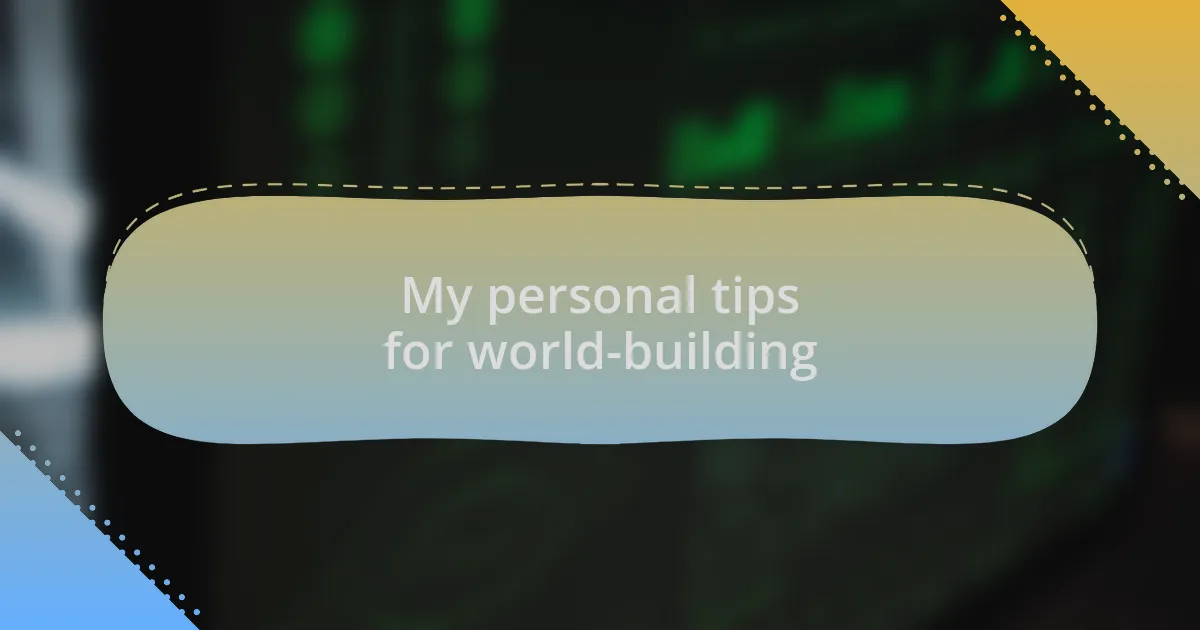
My personal tips for world-building
When I’m world-building, I make it a priority to create distinct cultures that feel alive and textured. I remember designing a desert nomad tribe, and I focused on their rituals around water—how it shaped their identity and values. Have you ever thought about how much small details can breathe life into a world? Those nuances not only make the culture believable but also enrich the overall narrative.
Another tip I swear by is drawing inspiration from real-world history. To develop conflict in a fantasy realm, I often look back at historical events, tweaking them to fit my universe. For instance, I once based a political struggle on the rise and fall of ancient empires, which added layers of depth to the conflict. Isn’t it fascinating how history can serve as a treasure trove of ideas for imaginative storytelling?
Finally, I encourage incorporating player choices into the world-building process. I find that allowing players to shape parts of the environment feels more immersive and engaging. One game I worked on featured player-driven events that would change the landscape. Reflecting on those decisions made their experiences feel personal. How have you seen player input transform game worlds? It’s a powerful tool to create meaningful connections and enhance gameplay.
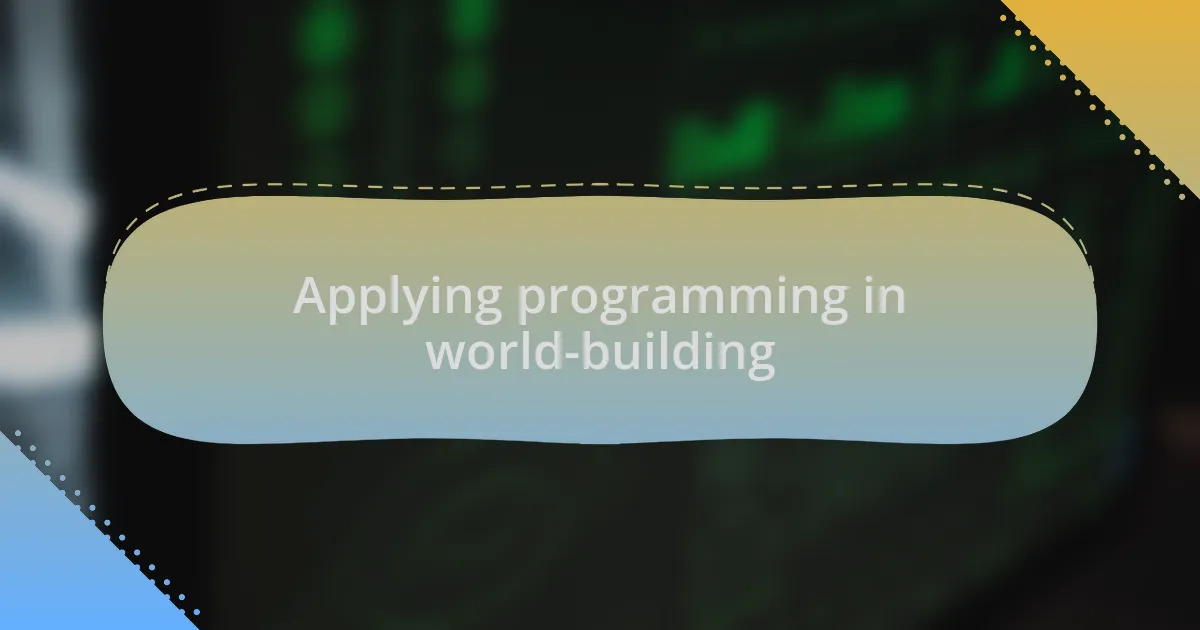
Applying programming in world-building
When I approach world-building through programming, I often think about the implementation of procedural generation. It allows me to create vast landscapes or intricate dungeons without manually crafting every detail. One time, I designed a forest that would spawn different creatures based on the time of day, which brought an element of surprise and discovery that players loved. Have you ever noticed how dynamic environments can make a game feel alive?
Incorporating AI-driven interactions has changed the way I develop characters within my worlds. I programmed non-player characters to react to player actions in unexpected ways, which led to some memorable game moments. For example, a character I created once changed their questline based on a previous choice I had made. The realization that players could genuinely influence character relationships brought an emotional weight to interactions that I had never anticipated. Isn’t it incredible how programming can create deeper narratives through responsive gameplay?
I also utilize scripting to create immersive events that unfold throughout the game world. One of my favorite projects involved writing scripts for a seasonal change event, where weather and festivals altered based on where the player was in the story. It felt rewarding to see how this not only affected gameplay but also enriched the cultural backdrop. Have you experienced a game where the world evolves alongside the narrative? Those moments of seamless integration are what make world-building so thrilling for me.